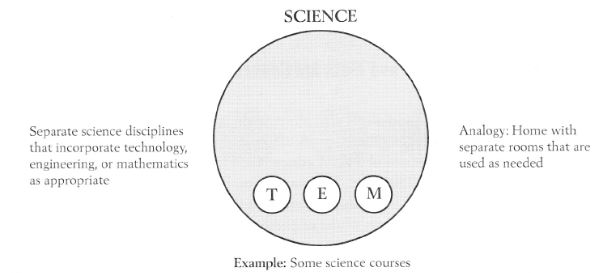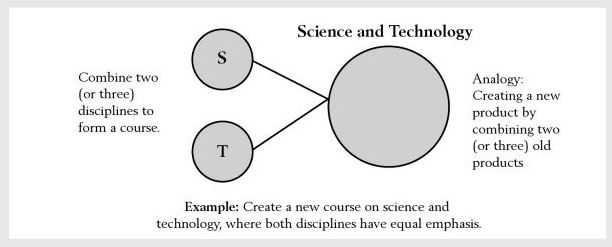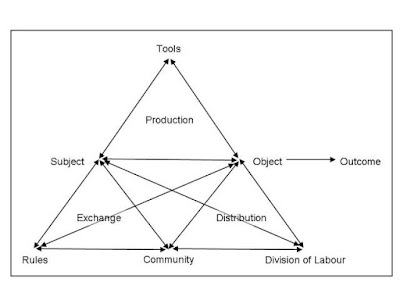The most comprehensive and coherent meta-analysis of the differing perspectives of STEM education comes from Rodger Bybee’s (2013) The Case for STEM Education: Challenges and Opportunities. Many current discussions of STEM view all of STEM as either science or mathematics, rather than separate delineations. This can be the most confusing because it contrasts multiple disciplinary orientations with a single discipline reference. The analogy Bybee (2013) uses is one of a forest ecosystem and looking for an individual tree. When teachers feel that STEM equals science or equal mathematics, then they incorrectly categorize STEM-foundational thinking as that found in a science or mathematics class (e.g.: scientific method or mathematical equation). To say that a single tree equates to an entire forest ecosystem is similarly misguided (see Figure 6).
 |
| Figure 6. STEM represented as a science discipline. |
Since science and mathematics are such a strong part of STEM education, many educators and district leaders feel that STEM refers to these disciplines, especially in middle and high schools. Bybee (2013) feels that this perspective “should not be surprising due to the long history of these disciplines as curricular components in American education” (p. 74) (see Figure 7).
 |
| Figure 7. STEM represented as separate disciplines of science and mathematics. |
Many teachers, especially science teachers, incorporate technology (and sometimes engineering) into their course of study. In this perspective, elementary school teachers often introduce an engineering-design cycle to students when solving a problem such as: how can you design a container that will protect an egg when dropped from a specific height? “This perspective represents the first step toward integration, but the teacher keeps science (or math) as the dominant discipline and, as appropriate or needed, introduces the other disciplines” (Bybee, 2013, p. 75) (see Figure 8).
 |
| Figure 8. Separate science disciplines that incorporates technology, engineering, or mathematics. |
When teachers teach specific subject areas, oftentimes, it is referred to “teaching in a silo” because their content area is separated from the other content areas. For example, the math department is separate from the science department. It is not surprising then that some teachers define STEM education as a series of separate content disciplines. With separate disciplines there is no connection between the two, similar to separate chapters or units of a textbook (see Figure 9). Bybee (2013) takes issue with this particular perspective because, especially in high school, although “the representation shows the silos as equal, this is not usually the case, especially when requirements for graduation are considered” (p. 76). Research on STEM education policy agrees with Bybee’s (2013) contention of this model. Oftentimes, different stakeholders have varying opinions about what STEM entails (Breiner et al., 2012), slowing down reform efforts.
 |
| Figure 9. STEM represented as separate disciplines (silos). |
Again, when science and mathematics are separate disciplines, there is little or no connection to each other. Many teachers attempt to bridge these content areas using technology or engineering (see Figure 10). For example, when preparing for a career that requires a technical education, many career and technical education (CTE) programs use this perspective of STEM education. The California project Linked Learning: Pathways to College and Career Success uses “technology and engineering projects to connect core subjects of science and math to experiences in professional and technical education in fields such as biomedical and health sciences, energy resources, information technology, and agriculture” (Bybee, 2013, p. 77).
 |
| Figure 10. STEM as connections between science and math made by technology and engineering |
When teachers make connections between the different content areas, STEM education becomes a coordination of specific concepts that will be used in other courses. For example, a science teacher may ask their mathematics colleague to introduce a concept that will be needed in science (see Figure 11). However, “less frequently do math teachers ask science or technology teachers to apply math concepts” (Bybee, 2013, p. 77). Bybee (2013) recognizes that this perspective represents an ideal because “in reality, two of the four disciplines likely will coordinate concepts and processes” (p. 77).
 |
| Figure 11. STEM as concepts, processes, and resources coordinated across separate disciplines. |
Another form of integration of disciplines occurs when teachers begin to combine two or more subjects in order to create another course. For example, a high school principal may decide to create a new science and technology course (see Figure 12). Here, both disciplines would have equal emphasis.
 |
| Figure 12. STEM model as combining two or more disciplines in order to form a course. |
According to Bybee (2013), “STEM can be integrated by sequencing disciplines in units or courses, or in lessons so STEM becomes a central emphasis of the education experience” (p. 78). This perspective offers a unique sequence of overlapping in order for students to progress through the disciplines (see Figure 13).
 |
| Figure 13. STEM represented as integrated disciplines. |
Finally, STEM education can be seen as a transdisciplinary course or program where real-world problems are addressed using each discipline: science, technology, engineering, and mathematics. For example, a high school could create a course called Sustainable Society where students could use “the entire group of STEM disciplines, and perhaps others (e.g.: ethics, politics, economics) to understand a major contemporary challenge” (Bybee, 2013, p. 78). By having a transdisciplinary approach to STEM education, students would be presented with issues such as global climate change, health problems, or renewable energy resources (see Figure 14).
 |
| Figure 14. STEM as transdisciplinary approach. |
Bybee (2013) does not offer preference for any of these STEM perspectives; however, for school or district-wide STEM integration, “the whole represents more value than just a sum of its parts” (Chiu, Price, & Ovrahim, 2015, p. 24). Good instructional design, collaboration, sustainable professional development, and organizational leadership are all key to any integrated program, but especially STEM education. Existing research on organizational performance and equitable school improvement discuss the need for values, collaboration and planning, curriculum and instruction, professional learning, and communication (Chiu, Price, & Ovrahim, 2015; Bryl, 2010; Seabring et al., 2006; Rogers, 1995; Basham, Israel, & Maynard, 2010; Wang et al., 2011; Wiebe et al., 2013; Mahoney, 2010).
Values. In looking at comparative case studies of 10 STEM-focused high schools, Scott (2012) found that a school’s mission statement has an overall impact on school culture. There is an obvious connection between a school’s mission statement and “the characteristics of the programs that each school provide[s]” (Chiu, Price, & Ovrahim, 2015, p. 6). Schools that have a strong STEM focus imbedded in their mission statement, culture, and leadership will have more successful STEM students, “whereas a principal who does not support science or science learning could do just the opposite” (Chiu, Price, & Ovrahim, 2015, p. 7). Both Bryk (2010) and Seabring, Allensworth, Easton and Luppescu (2006) offer five essential supports for school improvement that can also be tied to a strong STEM program: (a) leadership, (b) professional capacity, (c) parent-community ties, (d) student-centered learning, and (e) instructional guidance. According to Bryk (2010), “leadership drives change” (p. 25). Therefore, it only makes sense that one would question the form of leadership necessary to drive sustainable change. The leadership factors for successful school improvement are a combination of inclusive and instructional leadership. Closing the opportunity gap, especially with regards to STEM inequity, is a large problem that must begin at the local level. Teachers must have a “can-do” attitude continually seeking new ideas for culturally responsive pedagogy and STEM education. School improvement must involve parents. Teachers must “outreach to parents” in order to “develop common goals and understandings to strengthen student learning” (Seabring, Allensworth, Easton & Luppescu, 2006, p. 22). For example, having a STEM parent-outreach program connects parents and teachers so that they may collaborate in the best interests of their students. Having more parent involvement will also better hold teachers accountable for culturally responsive classroom practices. It makes sense that in order to increase student achievement one must have a school culture centered on student learning. This includes high academic standards and increased academic rigor for all students (especially those marginalized by the school system). Finally, a coherent instructional guidance system must be in place to increase student learning. This “articulates the what and how of instruction”, creates assessments that provide feedback to inform subsequent instructional decisions. There needs to be an emphasis on the need to “prepare all students to be proficient in STEM, including girls and minorities that are underrepresented in these fields, as well as to inspire these students to learn STEM and motivate them to pursue careers in these fields” (Chiu, Price, & Ovrahim, 2015, p. 8). Every grade level must be committed to STEM and students of color, and collaborating between grade levels so that teacher instruction is refined.
Collaboration and planning. Collaboration is “when members of an inclusive learning community work together as equals to assist students to succeed in the classroom” (Powell). Friend and Cook (1992, pp. 6-28) explain that collaboration has six defining characteristics: (a) collaboration is voluntary, (b) collaboration requires parity among participants, (c) collaboration is based on mutual goals, (d) collaboration depends on shared responsibility for participation and decision making, (e) individuals who collaborate share their resources, and (f) individuals who collaborate share accountability for outcomes.
Whenever one is trying to change a paradigm, it is important to recognize how people adapt to change. For example, Rogers (1995) discusses diffusion of technology as a series of stages, where the process occurs over time, however, I feel that his hypothesized distribution of adopters categories within a typical population can be used for implementing any sustainable change (see Figure 14).
 |
| Figure 14. Hypothesized distribution of adopter categories within a typical population. |
This bell curve indicates that voluntarily collaborating on the STEM equity gap will be easier for those innovators, early adopters, and early majority. Teachers will be able to set mutual goals and share not only the responsibility for participation and decision making, but also sharing resources and accountability. It is more difficult to engage the late majority and laggards, since closing the opportunity gap requires much more of a paradigm shift than just adopting new technology. Glen Singleton says that “race isn’t the only factor; it is the missing factor” and that to “see race is not racist. The meaning we attach to what we see can be racist” (p. 167). Basham, Israel, and Maynard (2010) suggest that teachers should work together as a team to make instruction authentic. Brown, Brown, and Merrill (2011) introduce the idea that science, technology, engineering, and mathematics teachers teach multiple concepts that lend themselves to possible collaboration on a daily basis. Collaborative STEM leadership “distributes power, authority, and responsibility across [a] group” (Anderson-Butcher et al., 2004, p. 4). True collaboration requires an interdependence “characterized by trust, norms of give-and-take, shared responsibilities, consensus-building and conflict resolution mechanisms, shared power and authority and shared information and decision-making systems” (Anderson-Butcher et al., 2004, p. 2). Collaborative teachers must agree to teach STEM in a framework that fits the school’s mission and vision before true integration is possible.
Curriculum and instruction. Current literature offers schools suggestions for STEM curriculum and instruction; however, there are limited examples. For example, projects such as Engineering is Elementary and Project Lead the Way offer teachers ways to integrate STEM into their curriculum. They provide example lesson plans and units for teachers to follow, but do not offer ways to create (or recreate) a system-wide elementary school STEM program, especially one that focuses on marginalized student populations.
Basham, Israel, & Maynard (2010) state:
The curriculum that is utilized in a school and its instructional practices are important pieces to look at when considering student achievement. STEM educational strategies must move beyond discipline-specific education. Integrating all disciplines offers students the opportunity to make sense of the world in an authentic way (p. 15)
True STEM integration requires applying all content to solving real-world problems.
Professional learning. Schools with an effective STEM program often place great importance on teacher professional learning. For example, “one barrier to successful STEM education is the lack of investment in the professional development of teachers to build a strong knowledge base in science, which has been attributed to poor student performance” (Ejiwale, 2013). In order to overcome this barrier, schools must adopt professional learning that can “simultaneously help existing teachers develop deeper understanding of the subjects they teach while exploring mechanisms for integration across STEM and non-STEM disciplines” (Chiu, Price, & Ovrahim, 2015, p. 14; Wang et al., 2011). When an organization has a sustained professional development program, with a clear understanding of the goals, both pedagogical practice and student achievement strengthen.
Communication. STEM in as acronym, which stands for Science, Technology, Education, and Mathematics. However, despite having a clear idea of the acronym, many teachers do not have a clear understanding of what STEM education means, especially in K-12 buildings. “A survey of educational professionals in Northeast Tennessee found that educators have a variety of definitions of STEM, including varied and contradictory terms such as student-focused, integration, hands-on, and project-based education (Chiu, Price, & Ovrahim, 2015, p. 15). Although these are good ideas in theory, educators and administrators need a clear definition of STEM education; one that is based on current research literature. If teachers do not understand STEM, then students will also have a disconnected perception, and will be unprepared for STEM careers upon graduation. For example, “surveys of grade 4-12 students show a lack of awareness of STEM careers, little opportunity to engage with STEM industries, and declining student attitudes in STEM subject areas (Wiebe et al., 2013; Mahoney, 2010, p. 30). School districts need to have clear communication, amongst staff, students, and the parent community, as to the definition STEM and justification for school-wide integration.
Summary
A review of the literature supports the need to create equitable access and opportunities to a rigorous curriculum centered on STEM-foundational thinking; however, there is a gap in STEM education literature for creating equal access and opportunities for underperforming students of color at the elementary level. Whereas previous research indicates a lack of diversity in STEM education and careers coupled with research on organizational performance and specific schools structures that support successful STEM integration, there is a need to research what elementary school structures are needed in order to support STEM-foundational thinking and instructional activities while supporting students of color in STEM curricular areas.




